Magento SEO: The All-In-One Definitive Guide
There are thousands of stores available in the market that are created using the Magento framework and are trying to win customers with the best content, design, and products. But there is one challenge that every site owner faces in this competitive world is to get a higher rank on the search engines. And to overcome this, businesses have started hiring the best Magento developers India who can follow the Magento SEO guidelines and use built-in SEO features of Magento to offer a top-ranking site to the businesses. To know more about the Magento SEO best practices to rank your Magento store higher in SERP, take a look at this blog.
1. Introduction to Magento SEO
1.1 What is Magento SEO?
SEO means search engine optimization which is a concept where a set of optimization practices are carried out for the website so that it can be easily found on search engines like Google and Bing. Magento SEO best practices enable eCommerce stores created on Magento to rank higher to get more traffic and leads from potential customers.
1.2 Why Does an eCommerce Site Need SEO?
SEO is one of the most powerful concepts that allows eCommerce websites to improve their search results which ultimately means that the number of buyers that land on the site will definitely increase. This can benefit your business a lot. Some of the most undeniable benefits that eCommerce sites get through SEO approaches are –
- SEO helps eCommerce websites to enhance the user experience.
- It is capable of bringing qualified organic customers to the eCommerce store.
- SEO for eCommerce sites helps in raising brand awareness and increasing the number of leads.
2. Magento SEO Guide: Key Factors to Bear in Mind
When it comes to Magento search engine optimization, the concept is a huge success as Magento is known as one of the best eCommerce platforms to consider SEO approaches. Magento supports a variety of features that helps you to optimize web pages easily. For instance, Magento enables the store owner or the developers handling the store to create a sitemap, offers them the control to write and redirect URLs, and offers them various extensions to optimize the site speed..
Magento SEO can be very helpful for the stores in the longer run. To know more about the key factors of Magento SEO, let’s go through the below points.
2.1 Authority:
Authority is one of the most essential factors when it comes to SEO. This means that if the search engines believe that the eCommerce store is secure, trustworthy, and helpful to the audience then it will be ranked higher. For this, there is some set of tips and tricks that needs to be taken into consideration to make the store get more authority. Besides this, a website with HTTPS encryption will get SEO benefits in ranking.
2.2 Relevancy:
Another factor of SEO is relevancy. This means that search engines require a clear idea of the site’s niche. If the search engine knows what the business is about and is aware of its true colors, they send the website to users when the relevant keyword has been entered by the users on search engines. For example, if the eCommerce store is for fashion, the content of the store must have relevant content with meta descriptions, title tags, and blogs about fashion only. Basically, optimizing content with proper keywords of the same niche and giving relevant image tags, can be very helpful to get the site on top of search engines.
2.3 User-friendliness:
Having a user-friendly website is one of the most important things. The main reason behind it is that when a visitor comes to the site, the user must be able to easily navigate through the entire site and get whatever he requires. For this, the structure of the website must be well-indexed. This is what search engine crawlers look out for in a website. They check the structure of the site and see if the site is fast & smooth. Basically, the website must be able to offer a seamless experience to the users and this has become more vital since the introduction of Google’s core web vitals, UX effects, and site speed concepts.
So before going deep into the Magento SEO guide, lighten your mood by seeing this core web vital meme.

3. Magento SEO Guide & Best Practices
Here are some of the major Magento SEO checklists that Magento developers must follow while building an eCommerce store.
3.1 Generate Magento XML Sitemap
An XML sitemap is an approach that enables search engines to crawl all the URL structure of the entire Magento website. It shows the search engines which pages, products and category URLs are required to get indexed and which are not. On the other hand, an HTML sitemap helps in making this information easily accessible for eCommerce users. Therefore, it must be a common practice to set up an HTML sitemap of the most important web pages of the site such as the product page, homepage, best-seller products, and more. The concept of HTML sitemaps isn’t supported by Magento 2 but with the help of Magento SEO extensions, generating HTML and XML sitemaps is an easy task for developers.
Besides this, generating HTML and XML sitemaps is also possible for a non-techie. Here are the steps that need to be followed to generate an XML sitemap easily –
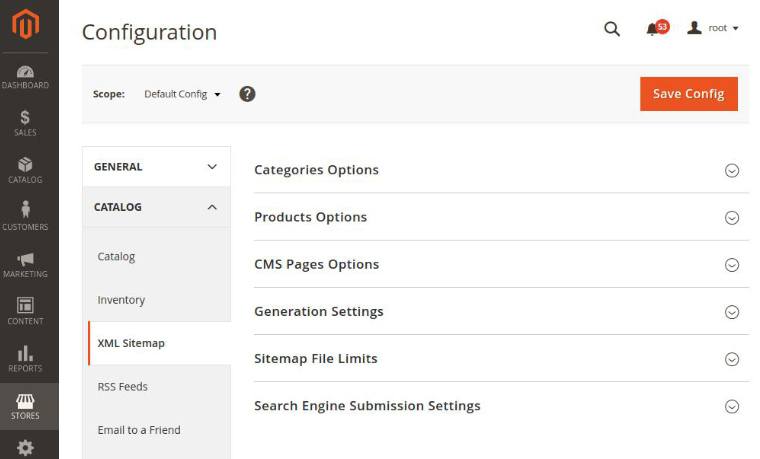
- First of all, Go to Marketing >> SEO and Search option > Site Map
- Now, click the Add Sitemap option.
- Here, you will have to fill in the sitemap’s name and path fields.
- Now, click Save & Generate.
- This will help you submit the sitemap to Search Engines. Here, if you want to submit a sitemap to Google, then click on submit to Google Search Console.
3.2 Prevent Duplicate Contents
One of the most important practices for Magento sites is to prevent duplicate content. Duplicate content means when your site has similar content to another website or from your own site’s other page whose URLs are already indexed. This kind of issue arises due to following factors:
- Faceted navigation: With the help of faceted navigation, users are able to find out the product they want to purchase by using the filtering option. Here the user filter can be as per the size, color, or brand of the product. This type of navigation makes the search easy and improves purchase ratio. This is why faceted navigation is a common feature in every big eCommerce site. But, when the filter combination is triggered on the website, a number of new duplicate pages are created.
- Internal search: Another thing is an internal search. Generally, people like to search a lot on eCommerce sites. This searching functionality creates a lot of duplicate pages as well. You don’t want those pages to be indexed in search engines.
This can be prevented with the use of canonical tags. Here’s an example of how this can be fixed.
Add rel=canonical tag to all duplicate pages.
<link rel="canonical" href="https://example.com/mobile-phones/samsung"> |
You will find it in the Magento console as well.
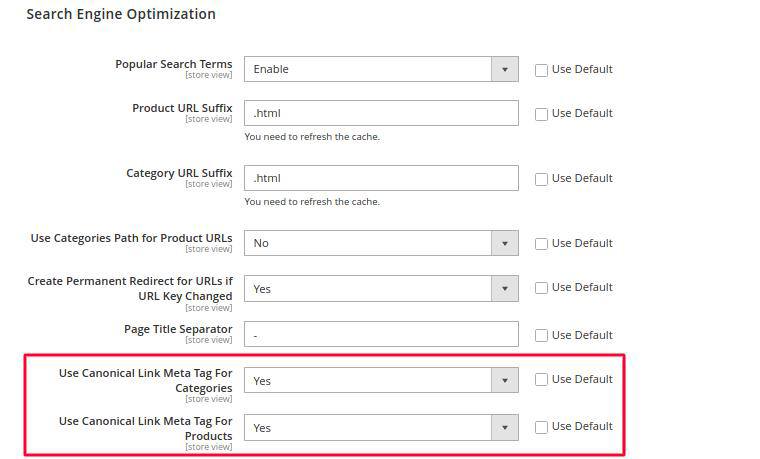
3.3 URL Optimization
URL optimization is another most important practice of Magento SEO. Here, the categories path option for product URLs enables the site owners to choose the paths of their product URLs and optimize them accordingly. URL optimization must be carried out so that proper SEO friendly URLs are assigned to the right page.
3.4 Internal Links
For any website, Google bots try to find out a relation between the web pages while crawling them. Search engine robots use internal links to check and move through the entire store while identifying what type of products the store sells. For instance, if the store is selling cosmetics and the crawler lands on the skin lotion page. If the lotion product page contains a link to a page that sells lipstick, the Google bot will move to the lipstick page and will realize that this site is selling cosmetics. Therefore, internal link building is very necessary. And this is what Magento 2 promotes with the Related Products feature.
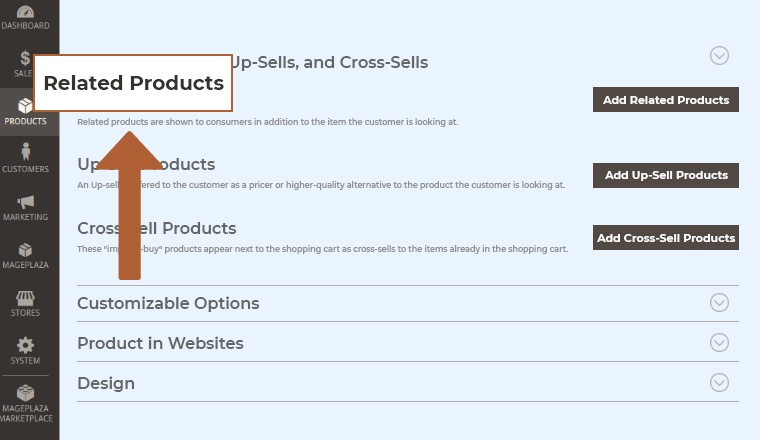
3.5 Revise Your Product Pages
To keep the eCommerce website up-to-date, revising the product pages and making them more relevant is a must. Depending on the past SEO investment, the web developers can help the site owners to edit a few older pages or revamp the entire product line-up. Magento allow you to configure product pages as per your requirements as shown in below image,
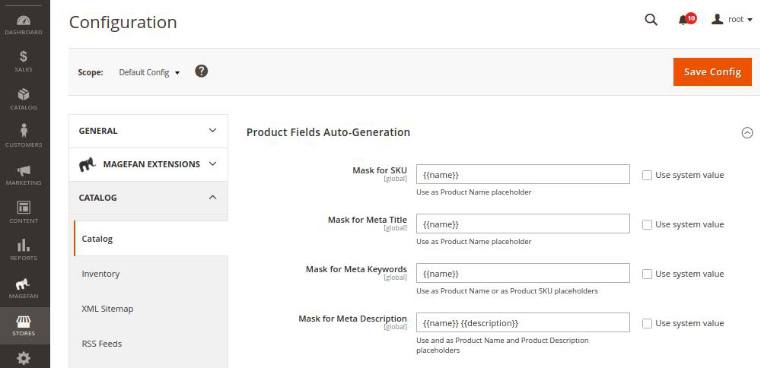
For improving the product pages, here are some of the major Magento best practices that can be taken into consideration.
3.5.1 Choose a Descriptive Product Name:
One of the most important things to do while improving the product page is to give it a descriptive name. The name of the product page must be as per the product’s category as it can help the users to find out the relevant products. For this, a proper keyword related to the product category must be added to the page’s name.
3.5.2 Unique Product Description:
After giving the page a proper name, the next thing to focus on is to create a full and short product description. Here the description of the product must be unique, informative, innovative and relative so that the users can know everything about the product by just going through the description.
3.5.3 Must Have a Relevant Title Tag and Meta Description:
For every product that is present in the store, there must be a product title tag and meta description.
3.5.4 Create a Concise URL:
For every product page, the URL should contain several important pieces of information like product name, model number, and manufacturer. This type of URL is taken as the best practice for Magento SEO.
3.5.5 Add Shopper Reviews:
When you show the reviews of the customers who have bought the products from you and liked them or have suggested something, this can help the new users to build their trust in your website and the products you are trying to sell. Therefore, adding shopper reviews to your product pages is a very important practice that every Magento store owner must follow.
3.6 Improve Magento Metadata
Metadata is the part of the source code of the website. With the use of meta data you can fix your title, description, robots and some other metadata of all the ecommerce pages. and is visible to search crawlers. The metadata isn’t visible anywhere on your website but is accessible to search crawlers.. Having relevant metadata is very useful if you want the site to rank well on the search engines. Metadata also helps in increasing the site’s CTA(click-through-rate) metrics and enables the crawlers to know what the website is all about. Therefore, improving the metadata is one of the best practices of Magento SEO.
Here is a perfect example of how Meta Title, Meta description should be used:

3.7 Use Robots.txt to Make Sure Unnecessary Links are not Indexed
Robots.txt has the capability to limit URLs that are crawled by search engines. This means that robots.txt informs the search engines about which URLs are not to be crawled. Some of the sites prefer the following links to be blocked by robots.txt.
- Login pages
- Facet Navigation
- Internal searches page
- The user’s shopping cart
Magento allows you to control the robots.txt with the following steps:
- Go to Content >> Design >> Configuration
- Choose the Store View to make a change and click Edit
- In the Search Engine Robots dropdown, add your robots.txt commands in the Edit custom instruction of robots.txt File field
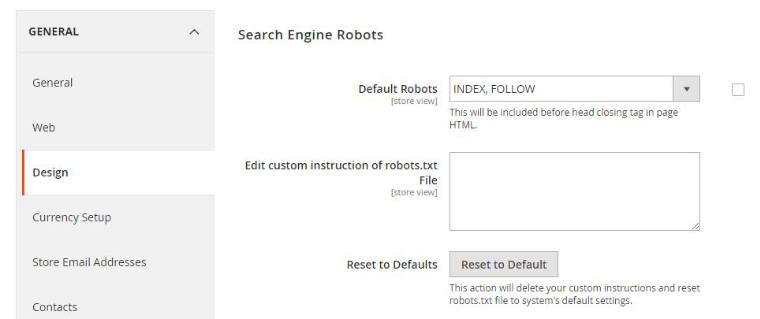
3.8 URL Rewrite and Redirect
It is one of the most important SEO best practices that you should implement. This practice comes into play when you’re changing the existing page URLs or worried about 404 pages. Basically, use this redirection method in order to help the customers and search crawlers to land on the right web page.Magento is best when it comes to URL rewrites and redirects as it enables the site owners or developers to create automatic and custom redirects.
The below image illustrates how to rewrite URLs in Magento.
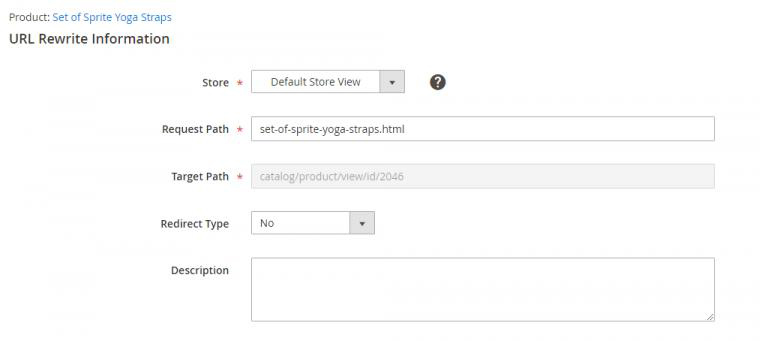
3.8.1 Automatic Redirects
When a site owner wants to create automatic redirects in a Magento 2 store, he has to go to Stores > then Configuration > select Catalog > choose Search Engine Optimization and then enable the Create Permanent Redirect for URLs. Here is an example of Automatic redirect URL.

3.8.2 Custom Redirects
Similarly, if there is a need to create a custom redirect manually where there can be 1:1 redirects, you can use the custom redirects option in Magento.
3.9 Homepage SEO Setting
The homepage is the most visited page on your website, even more popular than product and category pages. So, to improve Magento SEO, the first thing you have to do is to change the homepage title since it says “Homepage” by default.
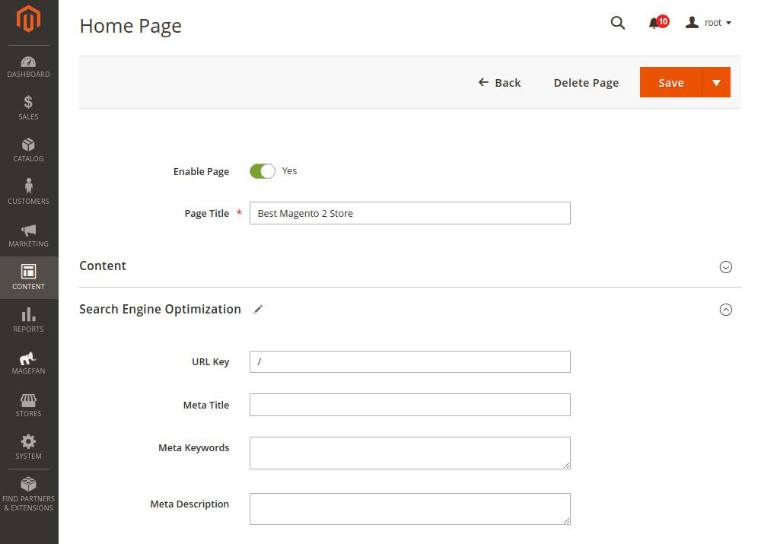
Not a very informative title, right?
Choose the name that describes your Magento 2 store best and go to Content > Elements > Pages > Home Page to set it up. Remember to use all the metadata including keywords that resonate with your store objectives.
3.10 Optimize for Page Speed
Optimizing your website page speed is a very important aspect of your ecommerce store. As if the website has the capability to load in less than five seconds then it can lead to almost 70% of longer user sessions. For this, the entire website pages must be optimized. Google also introduces page Speed insights where everyone can audit their page speed issues for absolutely free of cost.
So here are the things that must be considered while optimizing the page speed of the website to make it robust.
3.10.1 Compress Product Images:
eCommerce websites tend to have many images of the products they are selling which can affect the loading speed of the site. Because of this, before uploading the images of the products on the site, they must be compressed. The size of the images must be reduced without compromising the quality of the image.
3.10.2 Use Lazy Load:
Lazy Load is one of the best Magento SEO extensions that can be used to delay the image loading time to optimize the user experience. This extension enables the images on the website to get loaded as the user scrolls down the web page and it helps in ensuring that search engines can index the images properly while crawling.
3.10.3 Minimize Extensions:
Though there are many different Magento extensions available in the market, their use must be minimum. Because a lot of extensions can affect the speed of the website and eventually reduces the level of user experience.
3.10.4 Enable Flat Catalog:
When working on the Magento website, enabling the flat catalog allows the merging of product data into one table. This helps in improving the site’s loading time.
3.10.5 Use Full Page Caching:
Another way to improve the Magento store page speed is with caching. A cache is a reference for the store and instead of sending a query to the server, it refers to the most recent cache of the website which helps in getting faster results of the query.
4. How to Win Magento SEO?
As seen in this blog, there are various ways available to win Magento SEO. By following the recent SEO trends and right practices as discussed in this blog, the search engine optimization section for any Magento website can be checked and optimized. But for this, as the trends change in the market, the eCommerce site owners or the developers assigned to the project must change their practices of optimizing the site. This can help them get better results on the search engine, and eventually earn more by increasing the number of customers. Therefore, remembering the above-listed best Magento SEO practices and following them is highly advisable.

Hardik Dhanani has a strong technical proficiency and domain expertise which comes by managing multiple development projects of clients from different demographics. Hardik helps clients gain added-advantage over compliance and technological trends. He is one of the core members of the technical analysis team.
Laravel framework is the preferable choice from other PHP frameworks among large-scale businesses for developing their web development projects. Here are some of the facts...
 Dec 22, 2022
Dec 22, 2022 



First of all Thanks mate for putting these all Magento SEO best practices together so people like me don't need to go through so many websites just to find what I was looking for. There are so many other things that you can add to your blog to make it more appropriate and developer friendly but still looks decent though. Thanks.
Worth reading your blog. I just love the way you demonstrated Magento SEO best practices. I have been searching for this type of resource for a while. Thanks for sharing!